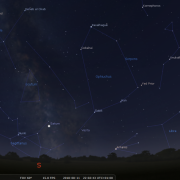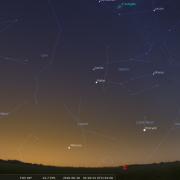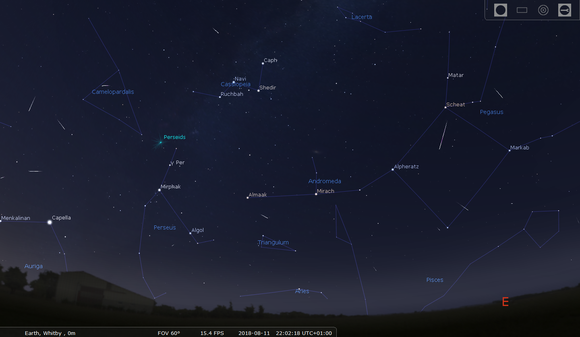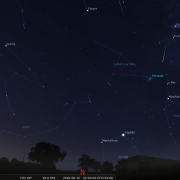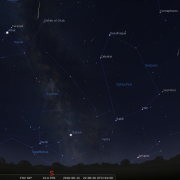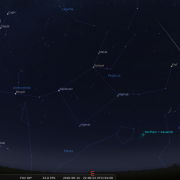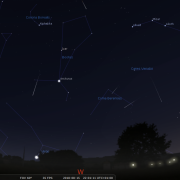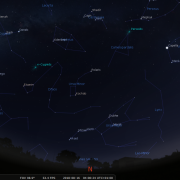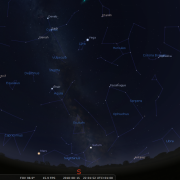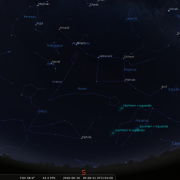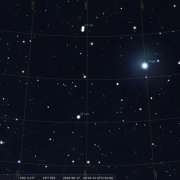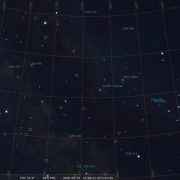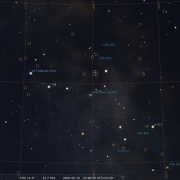Welcome to the WDAS monthly newsletter for August 2018: a digest of the month's latest contributions to our website. Below you'll find Society News, Sky Notes, the latest in Mark's monthly Crossing the Line series, as well as coming events.
Society News
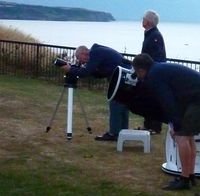 With the continuing good weather we have hosted a number of unscheduled star parties – and probably could have done more – but even Mark needs a break sometimes. Ironically the scheduled event on the 21st was almost called off with cloud cover during the day forecast to persist well into the night. It didn’t... well not enough to hamper our observations.
With the continuing good weather we have hosted a number of unscheduled star parties – and probably could have done more – but even Mark needs a break sometimes. Ironically the scheduled event on the 21st was almost called off with cloud cover during the day forecast to persist well into the night. It didn’t... well not enough to hamper our observations.
The Moon, Jupiter and Saturn all provided splendid views for people to enjoy, and enjoy they did, many staying until almost the end... most greatful for interrupting their planned walkabouts etc. Even Mars made a (very) brief appearance as it rose – ominously above the SE horizon. In fact the only planet to miss out was Venus: obscured by cloud, poor Venus.
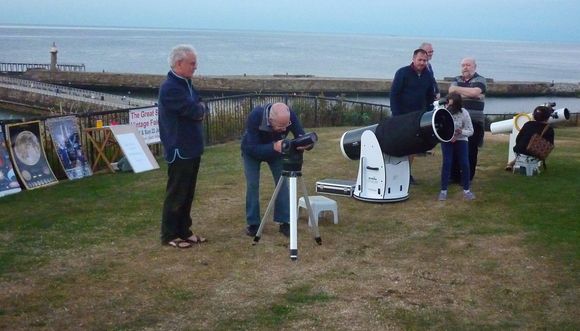
This was our second Park Fest event, a family fun day organised by North York Moors – Parks authority and held at the Danby Moors centre.
Keith and Mark made the journey over to Danby, Mark’s car packed with equipment and paraphernalia both necessary and in the ‘just in case’ bracket. Having made good time over and then unloaded pretty pronto too, allowed everything to be erected, laid out, hung up and arranged at a leisurely pace.
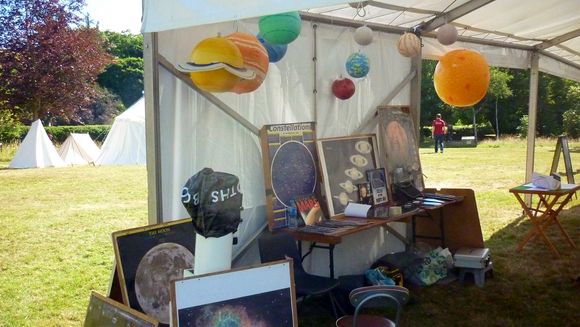
We had been allotted a couple of tables in the corner of the main marquee – a good position, as it afforded shelter from direct sunlight and allowed the scopes to be set up just outside the tent. Four instruments were selected, the two 2 Tal refractors, the 70mm Meade ETX refractor and the 6 “ Dobsonian. The table tops were dressed with magazines, books, maps and charts, whilst hanging from the Marquee structure was the inflatable solar system, Sun, Moon, Pluto and all.
After attaching the solar filters to the scopes it was crunch time. What would the Sun have to offer? A perfectly clean, blemish free round disk was the answer, not even a sun pimple let alone a spot. Oh well, at least the sun was visible unlike 2016 when we last attended Park Fest. The event officially opened at 11pm, and for a good while the public seemed a little thin on the ground. By midday however people began to flock onto the field, desperate to get a look at a clear white disk....
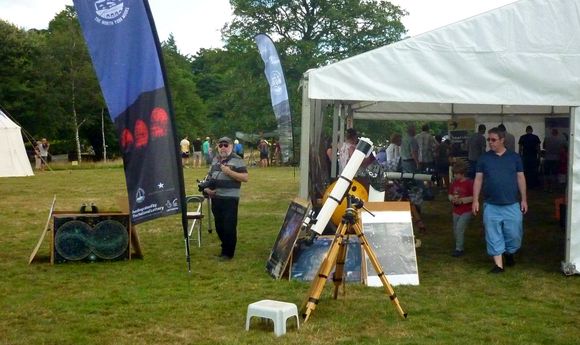
By 1pm Mark decided to seek out the MC and highjack the wandering mike, so that we could announce a set time for the scale solar system demonstration. So at 1:15pm Mark became MC for a while, asking for ‘planet’ hosts to come forward and participate. It took a little while, but eventually we had a dozen guinea pigs, much to the amusement of their parents.
The demonstration played rather well with more and more people looking on to see if the outer planets reached the extremities of the field. Utilising a flock of penned sheep to illustrate comets in the Oort cloud caused some mirth, but mostly bemusement with onlookers.
The demonstration did however stoke up interest in viewing our nearest star... still a blemish free disk, but being able to handle the building blocks of the solar system: our collection of meteorites, did prove popular.
The afternoon was dogged by more cloud, with the sun hiding for many short periods. These interludes did however allow time for an ice cream break as well as purchase some liquid produce from a stall in the back of the marquee. With the event finishing at 4pm, we had already moved back to the car items not required and by 4:15 we had completely reloaded.
A rather enjoyable day then, with further events on the horizon, the Moors Centre committing to star parties in October and next February, and the possibility of others too. 
 Well, the fireworks were quite good, but too early and it wasn’t dark enough. The cloud rolled in off the sea, so we hardly saw anything, but the evening was enjoyable and we may have gained some new members.
Well, the fireworks were quite good, but too early and it wasn’t dark enough. The cloud rolled in off the sea, so we hardly saw anything, but the evening was enjoyable and we may have gained some new members.
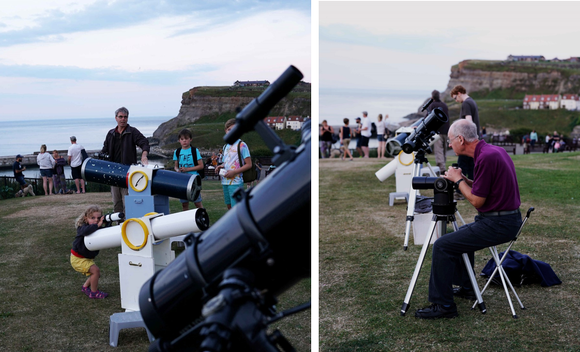
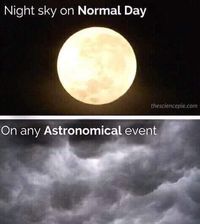
Image Credit: thesciencepie.com
AAaaaaaaaaaaaaaaaaaaaahhhhhh. Yep, the only evening required clear – or even partly clear; July 27th, turned out apocalyptic. Mark did venture up to the West Cliff for 20:45h, sat in the car, headlights on, peering through hell unleashed, along with a few other hardy and optimistic souls.
To paint the scene, you couldn’t even be creative and photograph the lightning strikes, because the rain was so heavy, which to add insult to injury grew even heavier around the time of the eclipse moonrise. Balrogs and demons, definitely the work of a wizard bent on ruining our chances of observing.
In the early hours of the morning – sometime, Mark did briefly see a veiled moon, but then again it may have been a dream, the nightmare already experienced earlier on. Still being reflective our disappointment pales into insignificance compared to the trials of Jean Baptiste Le Gentil. Look him up on the internet for the full story.
 The following evening skies cleared after earlier showers, leaving just interesting cloud formations to watch carefully.
The following evening skies cleared after earlier showers, leaving just interesting cloud formations to watch carefully.
Mark, Keith, Phil and John met up on the cliff and after deciding no more rain was forthcoming, set up the scopes hoping to entice people over. It turned out to be a decent observation session, with Venus, Jupiter, Saturn and Mars all on show.
Mars was telescopically a dancing red splodge, the others though were excellent and much appreciated by the public. Then the moon rose, looking almost full and attracting much attention with photographers, Mark took some through the ETX. If only, if only...
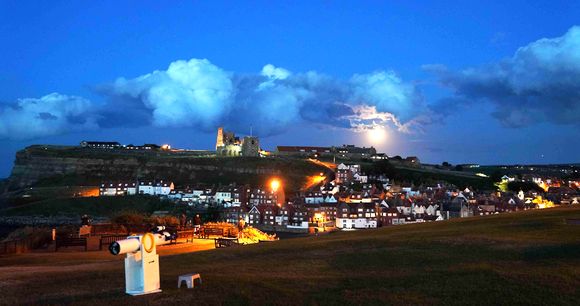
Moon and Mars (photo by Keith). larger picture (and others taken the same evening) in The Gallery
Then to off cap a great evening the ISS made a spectacular apparition, tracking high across the sky from SW to NE, much to the delight of all present. If only!
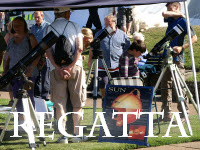 Not long before we hit the peak season (we hope) as regards star parties.
Not long before we hit the peak season (we hope) as regards star parties.
The Regatta events follow the usual route – afternoon solar viewing, on the Saturday (11th) and Sunday (12h), with evening star parties on both dates. The location of the solar viewing will i assume be as per last year ie – the grassy area adjacent to the small Go carts and Royal Crescent on the West Cliff. Time wise, we are looking at 14:00–16:30h.
The Star parties will be held on the pitch and put area, above the archery green – like last year. Parking is adjacent to this area - down the side of pitch and put, accessed over the parking area behind the bowling green. It is actually quite convenient. We shall be setting up around 20:30h. If the weather is good and you can make it, assistance would be most welcome.
As for the remainder of August – we have Folk week and the Bank holiday events to look forward to. In recent years (anything AD) August dates seem to be very susceptible to the weather, so quite a few are scheduled. Expect half to be called off. Again if it is a fine night on a scheduled date and you can make it please do come along.
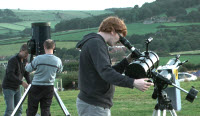 RHB: The timing of this year’s event is somewhat easier to set than last year, when various factors hindered suitable dates. So, ink in September 1st (Saturday) from 20:00h. As twilight deepens we should hopefully be able to observe Jupiter, Saturn and Mars, with a waning moon not rising until 22:30h allowing plenty of time for deep sky observations. The site is just off the B1447 (RHS) on the way down into Robin Hood Bay. If the weather is fine it promises to be a cracking evening.
RHB: The timing of this year’s event is somewhat easier to set than last year, when various factors hindered suitable dates. So, ink in September 1st (Saturday) from 20:00h. As twilight deepens we should hopefully be able to observe Jupiter, Saturn and Mars, with a waning moon not rising until 22:30h allowing plenty of time for deep sky observations. The site is just off the B1447 (RHS) on the way down into Robin Hood Bay. If the weather is fine it promises to be a cracking evening.
Westerdale: Although yet to confirm, we have pencilled in September 14th or 15th (more likely) for our visit to Westerdale village. Again this will be firmed up in the September newsletter.
Sky Notes
In this month's Sky Notes:
Planetary Skylights
 Venus now resides quite low in the west as twilight falls, setting no more than an hour after the Sun. A thin crescent moon lies above on the 14th (20:45h) but you will have to be sharp in spotting Venus as it will drop below the horizon within 20 minutes of this time.
Venus now resides quite low in the west as twilight falls, setting no more than an hour after the Sun. A thin crescent moon lies above on the 14th (20:45h) but you will have to be sharp in spotting Venus as it will drop below the horizon within 20 minutes of this time.

 Jupiter is now edging toward the WSW and is starting to slide down into the brighter evening twilight but remains on view throughout August, setting by 9:30pm at the end of the month. Although dropping lower Jupiter is nevertheless well worth observing, especially early August. Look in particular for the dark banding across the disk and the Galilean moons; the configuration of which alters each night. The Moon lies nearby Jupiter on the 17th.
Jupiter is now edging toward the WSW and is starting to slide down into the brighter evening twilight but remains on view throughout August, setting by 9:30pm at the end of the month. Although dropping lower Jupiter is nevertheless well worth observing, especially early August. Look in particular for the dark banding across the disk and the Galilean moons; the configuration of which alters each night. The Moon lies nearby Jupiter on the 17th.
 Saturn follows Jupiter across the southern aspect, but is also located quite low in the constellation of Sagittarius, just above the ‘teapot’ asterism. Look for a conspicuous pearly white ‘star’ in that direction. A modest telescope will reveal the ring system, which is currently orientated favourably; but due to low altitude patience is required at the eyepiece, waiting for those tantalising steady seeing moments. Look for the major gap in the rings, the Cassini division) and Saturn’s largest moon, Titan, visible as a speck of light close by. Our Moon lies nearby on the 20th and 21st.
Saturn follows Jupiter across the southern aspect, but is also located quite low in the constellation of Sagittarius, just above the ‘teapot’ asterism. Look for a conspicuous pearly white ‘star’ in that direction. A modest telescope will reveal the ring system, which is currently orientated favourably; but due to low altitude patience is required at the eyepiece, waiting for those tantalising steady seeing moments. Look for the major gap in the rings, the Cassini division) and Saturn’s largest moon, Titan, visible as a speck of light close by. Our Moon lies nearby on the 20th and 21st.
 Mars resides low to the SE, and having just reached opposition toward the end of July, it is seemingly still reluctant to show its ‘ruddy’ face before 10pm, especially if you do not have a flat unobstructed eastern aspect. The problem is Mars lies south of the ecliptic, which from the UK is already low during the summer months. Consequently, its fiery presence may be striking to the naked eye, but telescopically Mars all too often appears rather blurry, thanks to our turbulent atmosphere. The Red planet may be just over 35 million miles away, but it still appears smaller in the eyepiece than would be case if it had been the size of Venus. Still, there is the tantalising prospect of viewing the direct surface of another world, so have patience at the eyepiece and you will be rewarded.
Mars resides low to the SE, and having just reached opposition toward the end of July, it is seemingly still reluctant to show its ‘ruddy’ face before 10pm, especially if you do not have a flat unobstructed eastern aspect. The problem is Mars lies south of the ecliptic, which from the UK is already low during the summer months. Consequently, its fiery presence may be striking to the naked eye, but telescopically Mars all too often appears rather blurry, thanks to our turbulent atmosphere. The Red planet may be just over 35 million miles away, but it still appears smaller in the eyepiece than would be case if it had been the size of Venus. Still, there is the tantalising prospect of viewing the direct surface of another world, so have patience at the eyepiece and you will be rewarded.
Look for the polar caps, the dark markings of Mare Cimmerium and Tyrhenum and the fin shape of Syrtis Major.
The Moon lies above Mars on the 23rd.
 Finally, Mercury races into the early morning twilight by mid month, an apparition which lasts into September. Look for it 35–45 minutes before sunrise across in the ENE approximately one binocular field (around 7 degrees) above the horizon. It will be slightly higher and brighter towards the end of the month. If you cannot initially spot it with the naked eye, try with binoculars first.
Finally, Mercury races into the early morning twilight by mid month, an apparition which lasts into September. Look for it 35–45 minutes before sunrise across in the ENE approximately one binocular field (around 7 degrees) above the horizon. It will be slightly higher and brighter towards the end of the month. If you cannot initially spot it with the naked eye, try with binoculars first.
Meteors

One of the highlights on the astro-calendar, the Perseid meteor shower, peaks on August 12th this year and with the moon absent it should be a favourable observing opportunity.
Like the majority of meteor showers, Perseids are a classic example of a cometary debris shower, deposited over many thousands of years. Perseids are associated with comet Swift Tuttle which was discovered in 1862 and takes around 130 years to orbit the Sun. The nature of this meteoroid debris in size and density is not dissimilar to that of instant coffee granules with the occasional pea or marble sized fragment. Every August Earth encounters various strands of the Swift-Tuttle debris stream giving rise to the eagerly anticipated shooting stars.
Perseid meteoroids penetrate the upper atmosphere 60 miles up, reaching speeds of 43miles/second, interacting with atoms in the atmosphere as they do so, before becoming ionised and releasing a packet of light. It is this brief luminous flash we call a meteor. Particularly bright examples often leave behind persistent ionisation trails in their wake, the classic shooting star.
Perseids are so called because their radiant; the location in the sky from which the meteors appear to emanate lies within the constellation of Perseus, which will be rising in the north east during the evening. Perseid activity is highest from Aug 8th-15th reaching a peak this year on Aug 12th, but good rates can be expected during the nights of Aug 10-11 and 12-13, so don't just focus on the night of Aug 11-12 (and risk it being clouded out).
Under ideal conditions the zenith hourly rate (ZHR) for the Perseids is typically around 80. This assumes the radiant is overhead, light pollution is minimal and the observer has all round vision. Obviously then, such rates are rarely witnessed, but with moonlight absent, post midnight viewing should yield upwards of 40 per hour, with late evening viewing of around 15 per hour.
Observing meteors can be frustrating, just like the preverbal bus you can seemingly wait ages for one and then several appear within a few seconds. Have patience, wear warm clothing and perhaps have a warm drink and a snack to hand. Some people watch from a deck chair or lie-low.
Regions of the sky that often seem productive include; the ‘Summer Triangle’ visible high to the south, the Plough; high in the NW, and the Square of Pegasus, rising to the east. Avoid the area of sky Perseus occupies; ie over in the northeast. Shower members appearing close to the radiant have foreshortened tracks; those appearing farther away are often brighter, have longer tracks and move faster across the sky. Fingers crossed for clear skies and have fun.
August 2018 Sky Charts
|
Looking North
Mid-August - 22:00h |
Looking South |
|
Looking East
Mid-August - 22:00h |
Looking West
Mid-August - 22:00h |
|
Northern Aspect
Mid-August - 22:00h |
Southern Aspect
Mid-August - 22:00h |
| Northern Aspect (Early) Mid-August - 04:00h |
Southern Aspect (Early) Mid-August - 04:00h |
Additional Image Credits:
- Planets and Comets where not otherwise mentioned: NASA
- Sky Charts: Stellarium Software
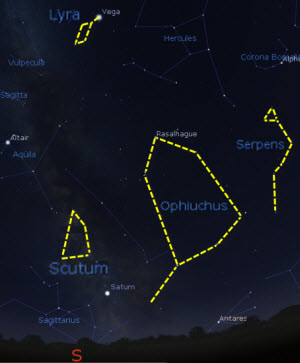 In our tour of stellar objects crossing the meridian line in August: a star and three open clusters from constellations lying in the South during the evening, currently above Mars and Saturn:
In our tour of stellar objects crossing the meridian line in August: a star and three open clusters from constellations lying in the South during the evening, currently above Mars and Saturn:
- A Star: Epsilon Lyrae, in Lyra
- and three Open Clusters:
- NGC 6633 in Ophiuchus
- Graff's Cluster (IC 4756) in Serpens
- Wild Duck Cluster (M11, NGC 6705) in Scutum
Star: Epsilon Lyrae, in Lyra
Above: Location of Epsilon Lyrae
in Lyra. 17-Aug-2018 at 22:00h
Below: chart of stars in Lyra
(Click for full-sized images)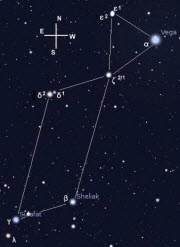
Naked eye/Binoculars/Telescope, Easy-Moderate
Amongst all the double stars visible in the heavens, there are few more distinctive than the famed Epsilon Lyrae, the "Double-Double in Lyra. It is located just to the northeast of brilliant Vega. The widest two components of the system are easily separated when viewed through binoculars, or with the naked eye under excellent conditions, and through very modest scopes they make for a great view, even under light polluted skies. The only caveat is to wait until epsilon high in the sky (summer and early autumn) when the view is less prone to be blurry due to the atmosphere, turning the wider pair of stars in to large blobs.
Rather than a single pair of stars Epsilon Lyrae splits into two pairs, Epsilon1 and Epsilon2. The northern component is called ε1 and the southern one is called ε2; The component stars of ε1 have magnitudes of 4.7 and 6.2 and are separated by 2.6", which corresponds to an average distance of 235 astronomical units (1 AU corresponds to 93 million miles –the Earth to Sum mean distance) They orbit with a period of around 1800 years, but the orbit is very elliptical 73 - 400AU.
Epsilon 2 component stars have magnitudes of 5.1 and 5.5 separated by 2.3" this equates to 724 years to orbit at a mean separation of 145 AU (95 to 195). Eps-1 and Eps-2 are separated by at least 10,000 AU (0.16 light years) taking at least 400,000 years to complete one orbit about each other. The whole system is located around 161 light years away. The spectral classes of the 4 components are all A, equating to temperatures or just over 8000 degrees K with luminosities of 14 -18 times that of the Sun. The whole system is probably 800 or so million years old. A fifth component of this system, orbiting one of the ε2 pair, was detected by speckle interferometry in 1985 its rapid motion suggests a period of a few tens of years. As a double star epsilon is easy to split with the naked eye or binoculars. To spot the double double a telescope is required. Easy-moderate. Crosses the south meridian line at 22:00h on Aug 17th.
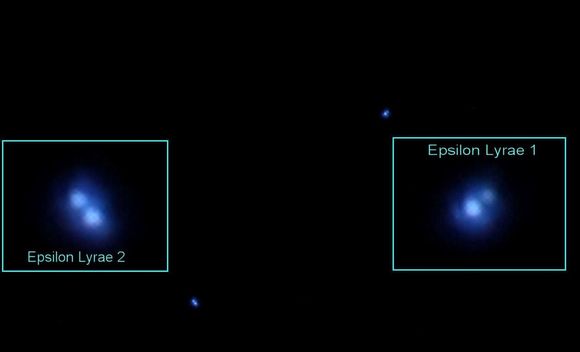
Star: Epsilon Lyrae, in Lyra (Image: Jenham's Astro YouTube video where you can see image captured.)
Open Cluster: NGC 6633 in Ophiuchus
Binoculars or Telescope at Low-power, Easy.
NGC 6633 is an open cluster, in the constellation of Ophiuchus, and actually lies in the direction of the Ophiuchus spur part of a spiral arm. It was supposedly discovered in 1745-46 by Philippe Loys de Chéseaux, and independently rediscovered by Caroline Herschel. Residing around 1200 light years distant, NGC 6633 lies in a very rich star field, and is nearly as large as the full moon, but is relatively sparse. The cluster contains 52 stars giving a total magnitude of 4.6; the brightest star being of mag 7.6. Its age is estimated to be around 600 million years, similar to the Hyades and Praesepa open clusters. This naked-eye cluster is a fine sight in a small telescope, which shows a group elongated NE-SW; the brightest are stars are on the SW end. An isolated clump of half a dozen stars lies on the west side. Viewed through anything more than a 10” scope on low power, the cluster starts to lose its aesthetic appeal. (For images and chart, see with Graff's Cluster, below.)
Cluster: Graff's Cluster (IC 4756) in Serpens
Location Chart for Graff's
Cluster and for NGC6633
on 14-Aug-2018 at 22:00h
(Click for full-sized image)
Binoculars or Telescope, Easy
Just 3° East of NGC 6633 residing in the “Cauda” or tail part of the constellation Serpens, lies the almost equally bright, but larger open cluster - IC 4756. Rather strangely it appears this cluster was not discovered until 1908, by Harvard astronomer Solon Bailey, but not visually only on plates taken as part of a systematic search for bright clusters and nebulae. The cluster was then independently visually discovered by German astronomer Kasimir Graff in 1922, only for sources to misidentify or erroneously list Graff 1 and IC 4756 as separate objects until finally rectified, so today the cluster bears Graff’s name and not Bailey’s.
The cluster is a fine sight at low power for all instruments up to 10” in aperture, just bear in mind that longer focal length telescopes yield a smaller field of view for any given eyepiece, and therefore the impact of this cluster will be lost. This may be the reason why it was not included or mentioned in historical catalogues or the likes of Messier, Herschell et al. Visually the group is enclosed within a large trapezoid of up to 80 magnitude 5-7stars, with many pairs and clumps in the central portions. The cluster lies approximately 1300 light years away and is a similar age to NGC 6633.
Incidentally, both NGC 6633 and IC 4756 are sometimes referred to as the Tweedle-Dum and Tweedle-Dee clusters due to their proximity in the sky. Both clusters - Binoculars and /or scope at low power –easy. Cross the meridian line around Aug 12th – 21:50–22:10h.
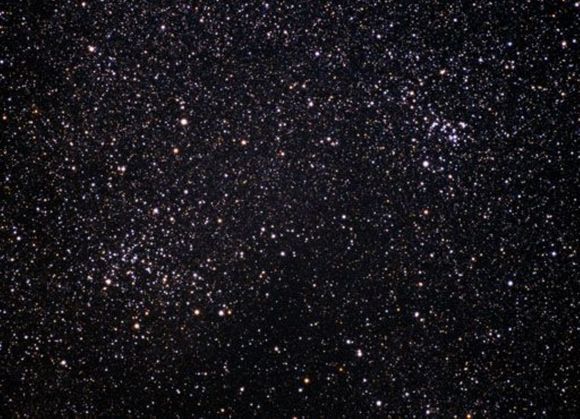
Open Cluster: Graff's Cluster in Serpens (left) and NGC 6633 (right) in Ophiuchus. Keen-eyed readers will have noted the two clusters are in different constellations, and from the top chart that Serpens appears on the right. In fact Serpens (the snake) is split into two parts by Ophiuchus (the snake bearer). The head (Serpens Caput) is on the right, while the tail (and home to Graff's Cluster, serpens cauda) protrudes from the bottom of Ophiuchus. (Image Credit: Unknown)
Open Cluster: Wild Duck Cluster (M11, NGC 6705) in Scutum
Telescope, Medium
The Wild Duck Cluster (also known as Messier 11, or NGC 6705) is an open cluster in the constellation Scutum. It was discovered by Gottfried Kirch in 1681, with the English astronomer William Derham first to resolve the cluster into stars around 1733. Charles Messier included it in his catalogue in 1764.
The Wild Duck Cluster is one of the richest and most compact of the known open clusters, containing about 2900 stars. located around 6000 light-years away it must span 20-25 light years across. The brightest, hottest main sequence stars in the cluster have the spectral classification of B8, the brightest designated HD 174512 (HIP 92507), is a giant with an apparent magnitude of 8.47. Messier 11 also contains 82 variable stars, many of which are pulsating variables and eclipsing binary stars. The cluster age is estimated to be 220-250 million years old
Of the 26 open clusters included in the Messier catalogue, M11 is the most distant that can be detected with the naked eye. It is also one of the few open star clusters in the Messier catalogue to have been observed by HST. When observed in a small telescope, however the brighter members of the cluster form a V-shaped triangle which sort of resembles a flock of ducks, which is how M11 got its name. The Wild Duck Cluster lies close to the northern part of the Scutum Cloud, a large star cloud that marks one of the brightest sections of the Milky Way. Messier 11 lies about a degree to the northwest of R Scuti, one of the first variable stars known discovered in 1795. In dark skies M11 appears as a patch of light just over 2 degrees west of the star i or 12 Aquilae, which lies just to the SW of Lambda Aquilae (Al Thalimain prior), the end star of Aquila whose chief star is Altair, southern most of the summer triangle stars.
At Magnitude +6.3 M11 is an easy binocular object, appearing as a diffuse fuzzy ball with a noticeably brighter centre. Smaller scopes will resolve M11 into a swarm of sparkling stars, with one bright standout member near the group's centre. When viewed through a larger 200mm (8-inch) scope, M11 is a spectacular sight with hundreds of stars visible including some yellow and red stars. Eye (just from dark sites) Binoculars and a Telescope – easy. Crosses the 180 degree S meridian line on Aug 19th at 22:00h.
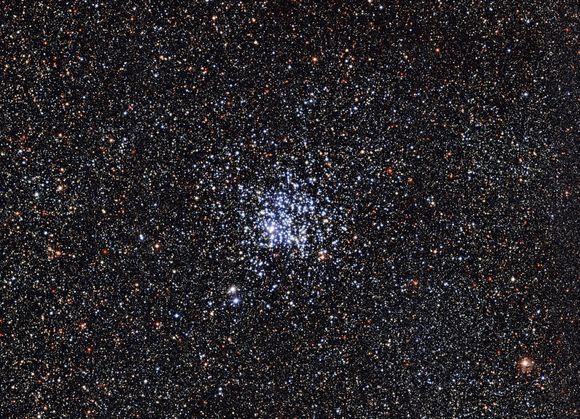
Open Cluster: Wild Duck Cluster (M11, NGC 6705) in Scutum: so-named because of a supposed
similarity to the triangle of a flock of ducks (Image Credit: ESO)

